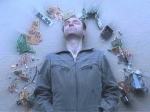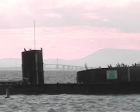Three films of mine are now publicly viewable, The Topologist (2010), its companion piece Collection of Cuts (2012), and Traces (2002), on my Vimeo page. It’s taken some time to put them online as I realize that a film unseen is a gaze unrecognized. I have always been a little surprised by the The Topologist and Collection of Cuts, given their highly personal natures, even as the versions of reality they describe continue to make sense to me. They would make new (non)sense if witnessed by others, as a universalized reality check.
Traces is from a time well before the making of The Topologist and Collection of Cuts, and would seem to have a different nature from these latter works. In contrast to the personal psychic fictions of The Topologist and Collection of Cuts, Traces presents as a documentary work on the intersection of art and science; a synaesthesia of audio tones and their directly resulting visual lissajous curves.
However, it is possible to draw connections between these apparently different works; all three challenge the idea of narrative and are explicitly experimental and exploratory. One might even say that in them there exists a dialectic between inner and outer space, that is, that what is presented as one is really a representation of the other, which leads to a conclusion that the original distinction is a contentious one. One could also say that the fluid reality of the Topologist and Cuts is somehow akin to the ever mutating shapes of Traces, as explorations of spaces that are happened upon, discovered not invented, following some deeper structures.
Furthermore, what if the differences between them only serve to emphasize their unity? Traces appears as a documentary, describing an objective reality that is reproducible and always available to the explorer armed with tone generators and an oscilloscope. Whereas The Topologist and Collection of Cuts are works of fiction, products of the imagination. Does this distinction keep them separate? It would seem that it is precisely this dialectic between the genres of documentary and fiction that helps us better understand the nature of film and the nature of reality. In fact, it is the tension between these terms that allows us to re-produce reality, to make it accessible…to make it at all.
Documentary and Fiction are both forms of re-presentation, each having its virtue depending on intention. It should not be said that one is superior to the other for describing reality. For to construct a documentary, many arbitrary decisions need to be made about content, about the ‘story’ that one wants to tell. This documentary ‘story’ is immediately analogous to the fictional ‘story’; both require choices on subject matter and choices on the point-of-view from which that story is told. Indeed, we approach the tension between ‘imagination’ and ‘truth’, only to realize that one leads to the other, and that there is a necessity for both in the representation of reality, or, that reality can bear being represented in both forms.
Therefore, to say that Traces is simply a documentary of audio visual geometry allows us to miss the significance of infinite forms and deeper structures that have implications for biology as much as for psychoanalysis. These forms can serve to unnerve the notion of teleology and fixed subjectivity. They also exemplify the idea that small changes in initial conditions (e.g. changing the frequency of the audio tone) can lead to vast and unpredictable outcomes (the resulting lissajous curves). But what of the curves themselves in Traces? Apart from the conjuring of archetypal shapes (squares, circles, etc) that verify one mathematical reality, one might, as I do – see letters, biological and geological forms, future design vectors and complex noise.
Similarly, to say that The Topologist and Collection of Cuts are works of fiction is to miss their description of reality. Their non-narrative nature is itself part of this description, but it is the intended poetry of the metaphoric scenes that becomes the better (the only?) technique to describe the character of the Topologist – the way it feels for him, the way he sees and experiences it, and the way he misunderstands things. (One could even say that the character’s predicament is one of topolosoIipsism.) I understand that the best way to describe reality is to fictionalize it. It is through extrapolation, embellishment and invention that the texture of reality is best comprehended. Obversely, if one wants to tell a really ‘tall’ tale, then make it as a documentary.
Lastly, these works have the influence of the 20th century inscribed all over them, from the tropes of experimental film of the 60s and 80s, to the use of a cathode ray oscilloscope. More precisely, they acknowledge that film is the memory of the 20th century, it is its seeing, its hallucination of the real.
—-
Read the related short essays:
Transfusion: Video, Topology, Sisyphus and The Topologist: Super8 SuperMemory
View the related short film and music video:
The Room and Post Utopian Pause
—-



